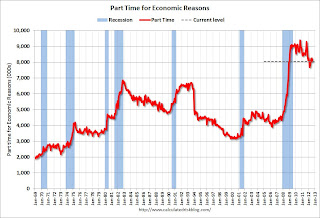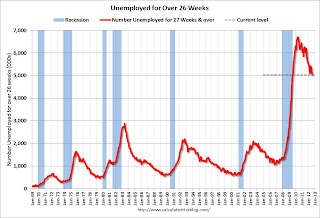by Calculated Risk on 9/07/2012 10:26:00 AM
Friday, September 07, 2012
Employment: Another Weak Report (more graphs)
The economy has added 1.11 million jobs over the first eight months of the year (1.21 million private sector jobs). At this pace, the economy would add around 1.8 million private sector jobs in 2012; less than the 2.1 million added in 2011. Also, at this pace of payroll job growth, the unemployment rate will probably still be above 8% at the end of the year.
Government payrolls declined another 7 thousand in August, bringing government job losses to 93,000 for 2012 through August (61,000 state and local jobs losses so far in 2012, and 32,000 fewer Federal jobs).
Some numbers: There were 96,000 payroll jobs added in August, with 103,000 private sector jobs added, and 7,000 government jobs lost. The unemployment rate decreased to 8.1% (from the household survey), and the participation rate declined to 63.5%. The decline in the unemployment rate was mostly due to the lower participation rate.
U-6, an alternate measure of labor underutilization that includes part time workers and marginally attached workers, declined to 14.7%.
The change in payroll employment for July was revised down from +163,000 to +141,000, and June was revised down from +64,000 to +45,000, for a total revision of minus 41,000 over those two months.
The average workweek was unchanged at 34.4 hours, and average hourly earnings declined slightly. "The average workweek for all employees on private nonfarm payrolls was unchanged at 34.4 hours in August. ... In August, average hourly earnings for all employees on private nonfarm payrolls edged down by 1 cent to $23.52. Over the past 12 months, average hourly earnings rose by 1.7 percent." This is sluggish earnings growth.
There are a total of 12.5 million Americans unemployed and 5.0 million have been unemployed for more than 6 months.
This was another weak employment report, especially with the downward revisions and slight decline in hourly earnings. Here are a few more graph ...
Employment-Population Ratio, 25 to 54 years old
 Click on graph for larger image.
Click on graph for larger image.
Since the participation rate has declined recently due to cyclical (recession) and demographic (aging population) reasons, an important graph is the employment-population ratio for the key working age group: 25 to 54 years old.
In the earlier period the employment-population ratio for this group was trending up as women joined the labor force. The ratio has been mostly moving sideways since the early '90s, with ups and downs related to the business cycle.
This ratio should probably move back to or above 80% as the economy recovers. So far the ratio has only increased slightly from a low of 74.7% to 75.6% in August (this was up slightly in August.)
Percent Job Losses During Recessions

This graph shows the job losses from the start of the employment recession, in percentage terms - this time aligned at maximum job losses.
In the earlier post, the graph showed the job losses aligned at the start of the employment recession.
Part Time for Economic Reasons
 From the BLS report:
From the BLS report:
The number of persons employed part time for economic reasons (sometimes referred to as involuntary part-time workers) was little changed at 8.0 million in August. These individuals were working part time because their hours had been cut back or because they were unable to find a full-time job.The number of part time workers decrease in August to 8.03 millon from 8.25 million in August.
These workers are included in the alternate measure of labor underutilization (U-6) that decreased in August to 14.7%, down from 15.0% in July.
Unemployed over 26 Weeks
 This graph shows the number of workers unemployed for 27 weeks or more.
This graph shows the number of workers unemployed for 27 weeks or more. According to the BLS, there are 5.03 million workers who have been unemployed for more than 26 weeks and still want a job. This was down from 5.18 million in July. This is generally trending down and is at the lowest level since 2009. Long term unemployment remains one of the key labor problems in the US.
State and Local Government
So far in 2012 - through August - state and local government have lost 61,000 jobs (10,000 jobs were added in August). In the first eight months of 2011, state and local governments lost 168,000 payroll jobs - and 230,000 for the year. So the layoffs have slowed, but they haven't stopped.
 This graph shows total state and government payroll employment since January 2007. State and local governments lost 129,000 jobs in 2009, 262,000 in 2010, and 230,000 in 2011.
This graph shows total state and government payroll employment since January 2007. State and local governments lost 129,000 jobs in 2009, 262,000 in 2010, and 230,000 in 2011.Note: Some of the stimulus spending from the American Recovery and Reinvestment Act probably kept state and local employment from declining faster in 2009.
Of course the Federal government is losing workers too (43,000 over the last 12 months, although 3,000 added in August). I think state and local government employment losses might slow further over the next several months.
Overall this was another weak report.


